Symmetry Breakdown Related Fracture in 42CrMo4 Steel
Abstract
1. Introduction
2. Materials and Methods
3. Results
4. Discussion
- A.
- The crack through the fractured subunits (i.e., blocks or laths) obeys elastic-plastic fracture mechanics (EPFM) and has a plastic zone upon the plane-strain condition;
- B.
- The inter-subunit fracture is insignificant after austempering below the martensite start temperature (ABMS);
- C.
- The radius of the selected integration contour for the path-dependent J-integral is quantized by the average effective path of the crack propagating through individual subunits;
- D.
- A uniform distribution of the crystallographic symmetry of grains is assumed.
5. Conclusions
Author Contributions
Funding
Data Availability Statement
Acknowledgments
Conflicts of Interest
References
- Jiang, Y.F.; Zhang, B.; Zhou, Y.; Wang, J.Q.; Han, E.H.; Ke, W. Atom probe tomographic observation of hydrogen trapping at carbides/ferrite interfaces for a high strength steel. J. Mater. Sci. Technol. 2018, 34, 1344–1348. [Google Scholar] [CrossRef]
- Navarro-López, A.; Hidalgo, J.; Sietsma, J.; Santofimia, M.J. Influence of the prior athermal martensite on the mechanical response of advanced bainitic steel. Mater. Sci. Eng. A 2018, 735, 343–353. [Google Scholar] [CrossRef]
- Feng, J.; Frankenbach, T.; Wettlaufer, M. Strengthening 42CrMo4 steel by isothermal transformation below martensite start temperature. Mater. Sci. Eng. A 2017, 683, 110–115. [Google Scholar] [CrossRef]
- Weidner, A.; Lippmann, T.; Biermann, H. Crack initiation in the very high cycle fatigue regime of nitrided 42CrMo4 steel. J. Mater. Res. 2017, 32, 4305–4316. [Google Scholar] [CrossRef]
- Kim, H.; Liu, Z.C.; Cong, W.L.; Zhang, H.C. Tensile Fracture Behavior and Failure Mechanism of Additively-Manufactured AISI 4140 Low Alloy Steel by Laser Engineered Net Shaping. Materials 2017, 10, 1283. [Google Scholar] [CrossRef] [PubMed]
- Morito, S.; Tanaka, H.; Konishi, R.; Furuhara, T.; Maki, T. The morphology and crystallography of lath martensite in Fe-C alloys. Acta Mater. 2003, 51, 1789–1799. [Google Scholar] [CrossRef]
- Kinney, C.; Pytlewski, K.; Qi, L.; Khachaturyan, A.G.; Morris, J.W. An investigation into 6-fold symmetry in martensitic steels. Metall. Mater. Trans. A 2016, 47, 5266–5270. [Google Scholar] [CrossRef]
- Biezeno, C.B.; Grammel, R. Grundgesetze der Elastomechanik. In Technische Dynamik: Erster Band Grundlagen und Einzelne Maschinenteile; Biezeno, C.B., Grammel, R., Eds.; Springer: Berlin/Heidelberg, Germany, 1953; pp. 1–79. [Google Scholar] [CrossRef]
- Cotterell, B. On brittle fracture paths. Int. J. Fract. Mech. 1965, 1, 96–103. [Google Scholar] [CrossRef]
- Feng, J.; Wettlaufer, M. Characterization of lower bainite formed below MS. HTM J. Heat Treat. Mater. 2018, 73, 57–67. [Google Scholar] [CrossRef]
- Feng, J.; Wettlaufer, M. Plane-strain fracture toughness of AISI 4140 steel austempered below MS. Mater. Sci. Eng. A 2019, 743, 494–499. [Google Scholar] [CrossRef]
- Beladi, H.; Rohrer, G.S.; Rollett, A.D.; Tari, V.; Hodgson, P.D. The distribution of intervariant crystallographic planes in a lath martensite using five macroscopic parameters. Acta Mater. 2014, 63, 86–98. [Google Scholar] [CrossRef]
- Gourgues, A.F.; Flower, H.M.; Lindley, T.C. Electron backscattering diffraction study of acicular ferrite, bainite, and martensite steel microstructures. Mater. Sci. Technol. 2000, 16, 26–40. [Google Scholar] [CrossRef]
- Suikkanen, P.P.; Cayron, C.; DeArdo, A.J.; Karjalainen, L.P. Crystallographic Analysis of Martensite in 0.2C-2.0Mn-1.5Si-0.6Cr Steel using EBSD. J. Mater. Sci. Technol. 2011, 27, 920–930. [Google Scholar] [CrossRef]
- Kurdjumov, G.; Sachs, G. Over the mechanisms of steel hardening. Z. Phys. 1930, 64, 325–343. [Google Scholar]
- Wassermann, G. Einfluß der α-γ-Umwandlung eines irreversiblen Nickelstahls auf Kristallorientierung und Zugfestigkeit. Arch. Eisenhütt. 1933, 6, 347–351. [Google Scholar] [CrossRef]
- Wittridge, N.J.; Jonas, J.J. The austenite-to-martensite transformation in Fe–30%Ni after deformation by simple shear. Acta Mater. 2000, 48, 2737–2749. [Google Scholar] [CrossRef]
- Broek, D. The Crack Tip Plastic Zone. In Elementary Engineering Fracture Mechanics; Springer: Dordrecht, The Netherlands, 1982; pp. 91–114. [Google Scholar] [CrossRef]
- Cahn, R.W. Twinned crystals. Adv. Phys. 1954, 3, 363–445. [Google Scholar] [CrossRef]
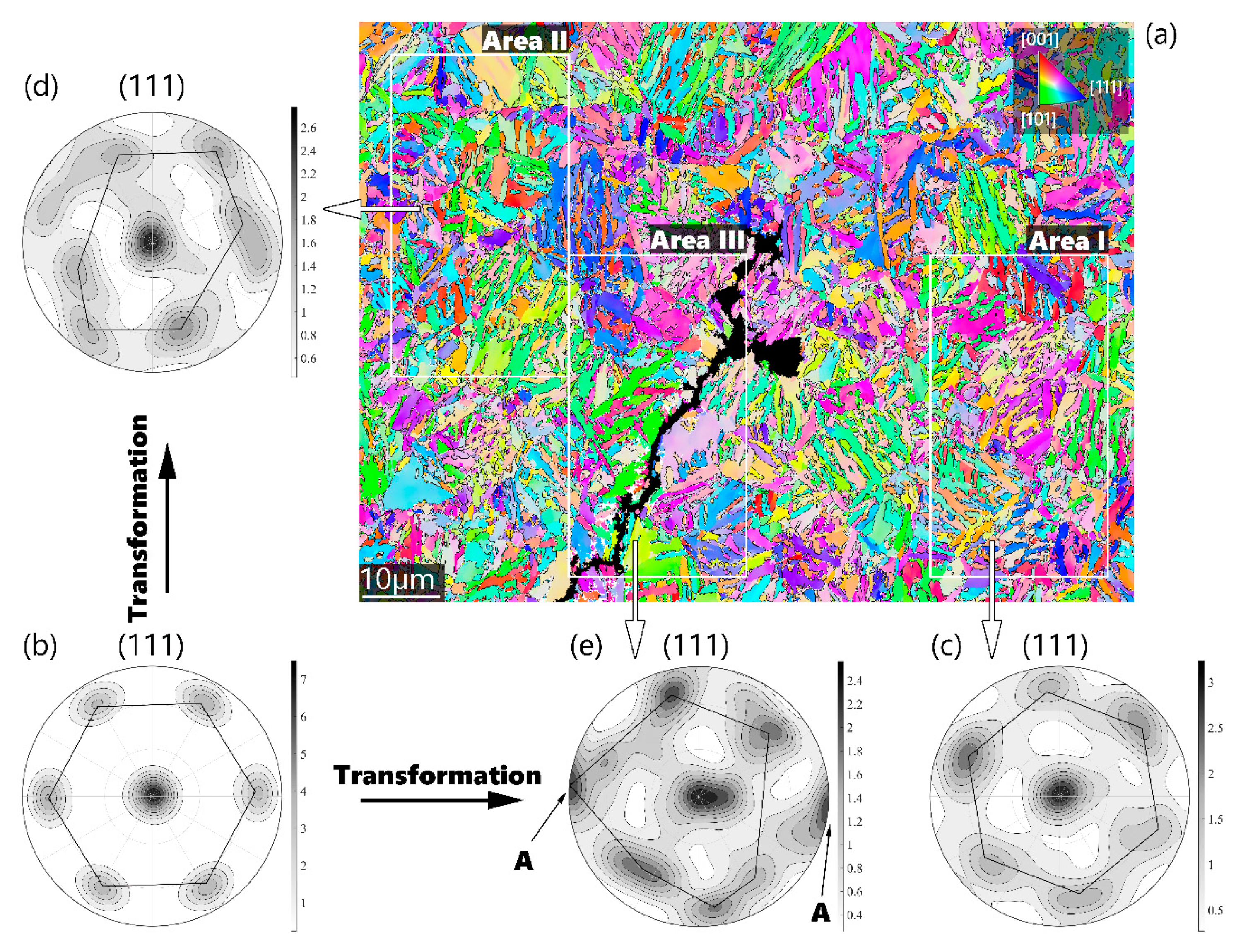
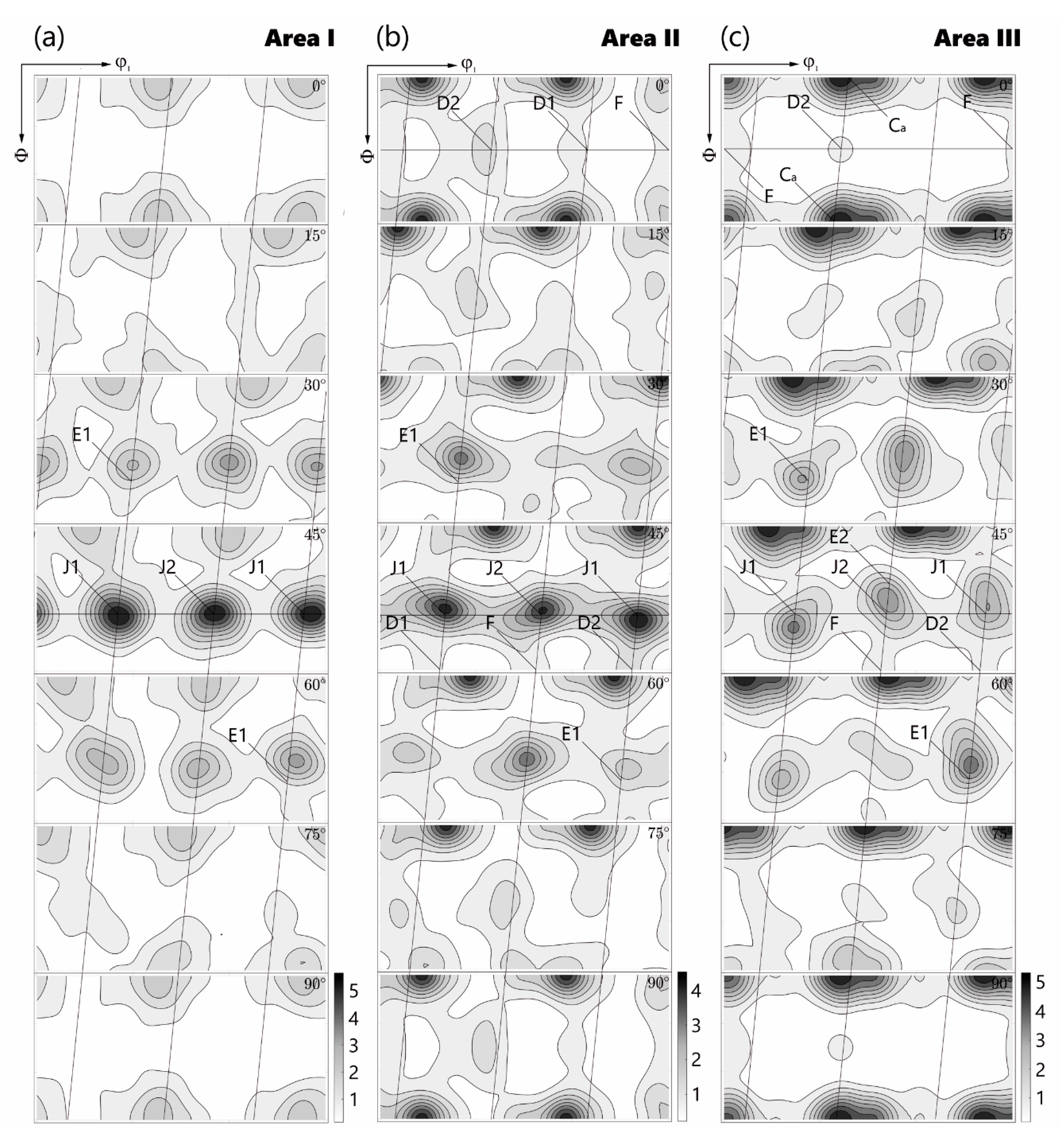

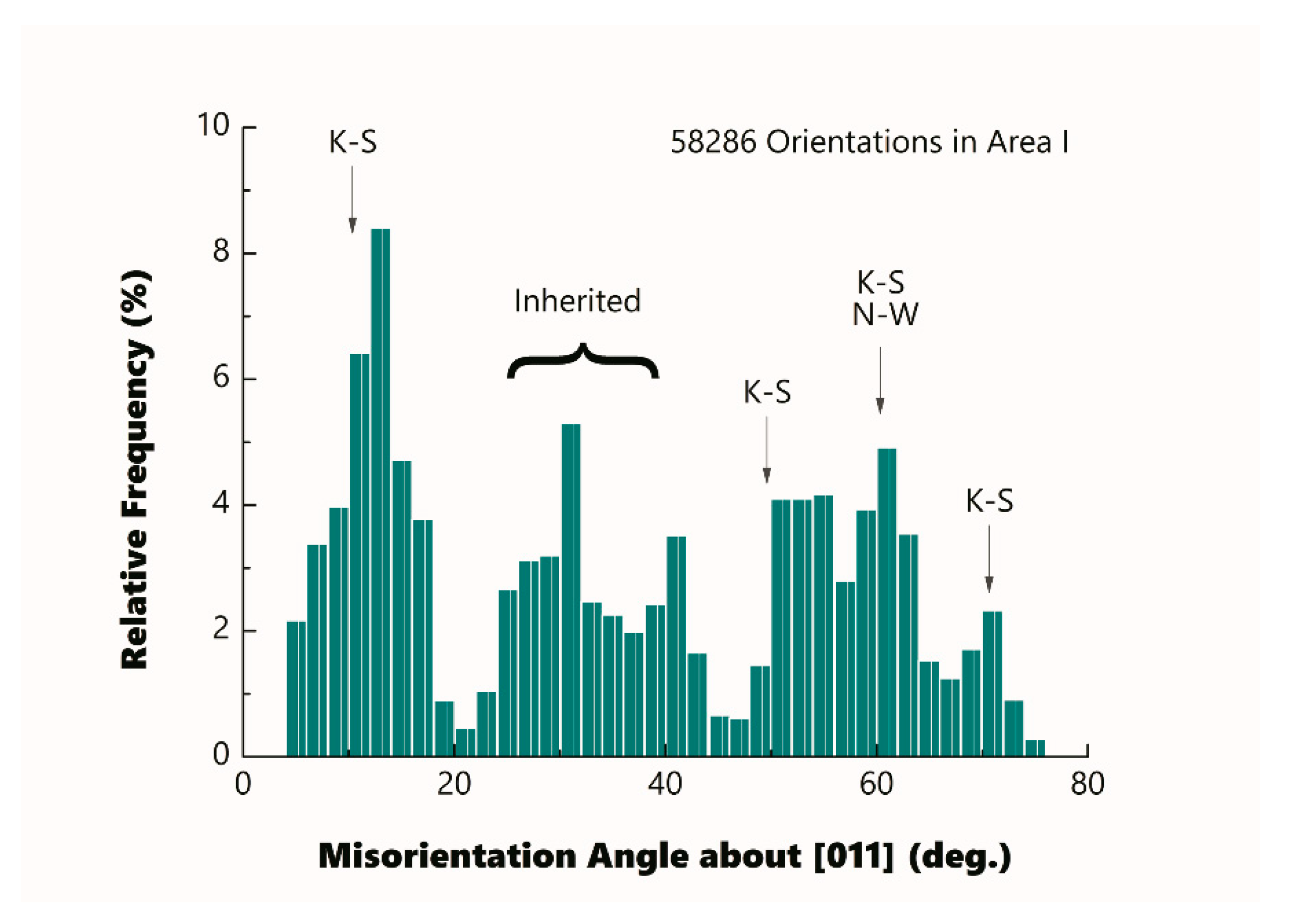
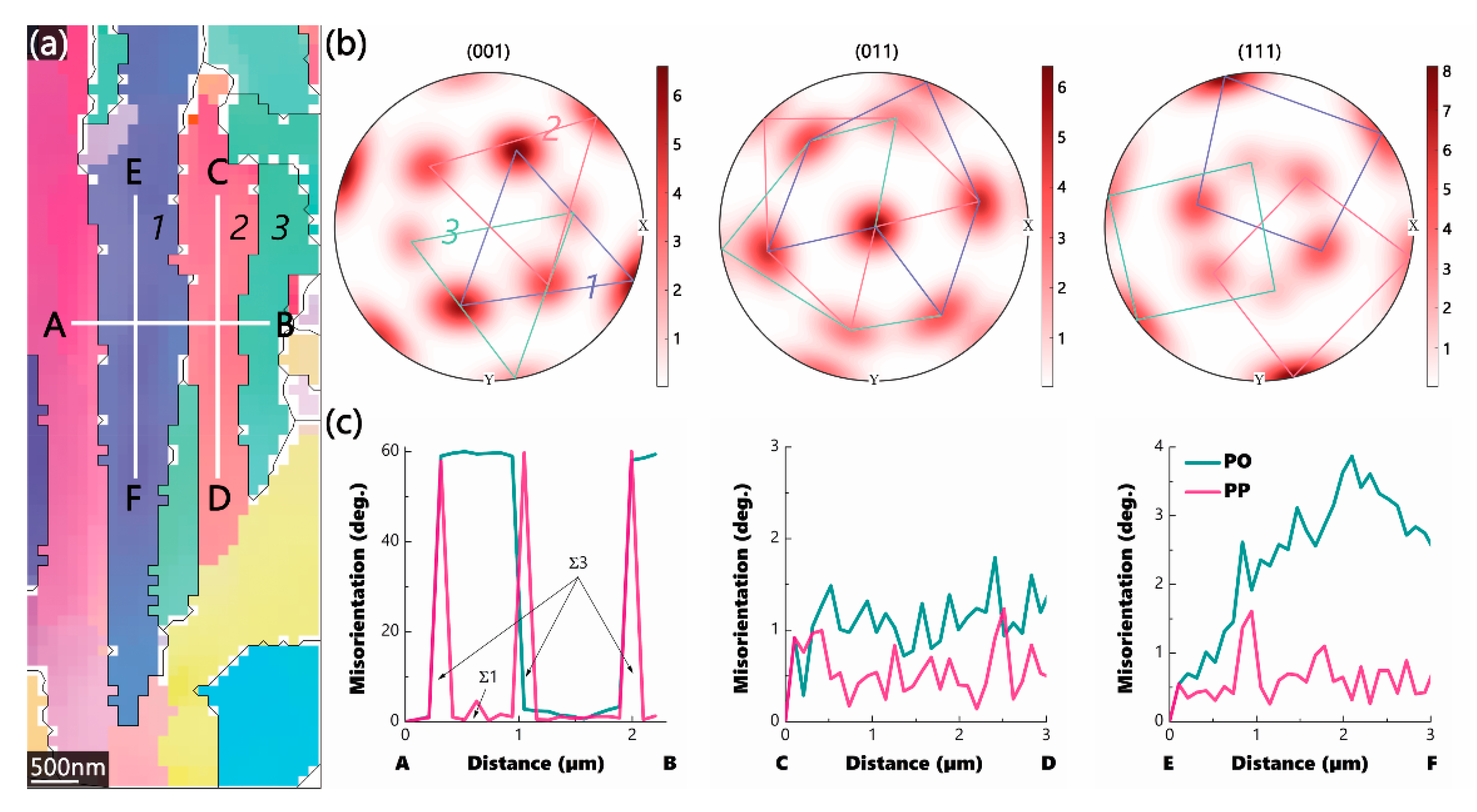
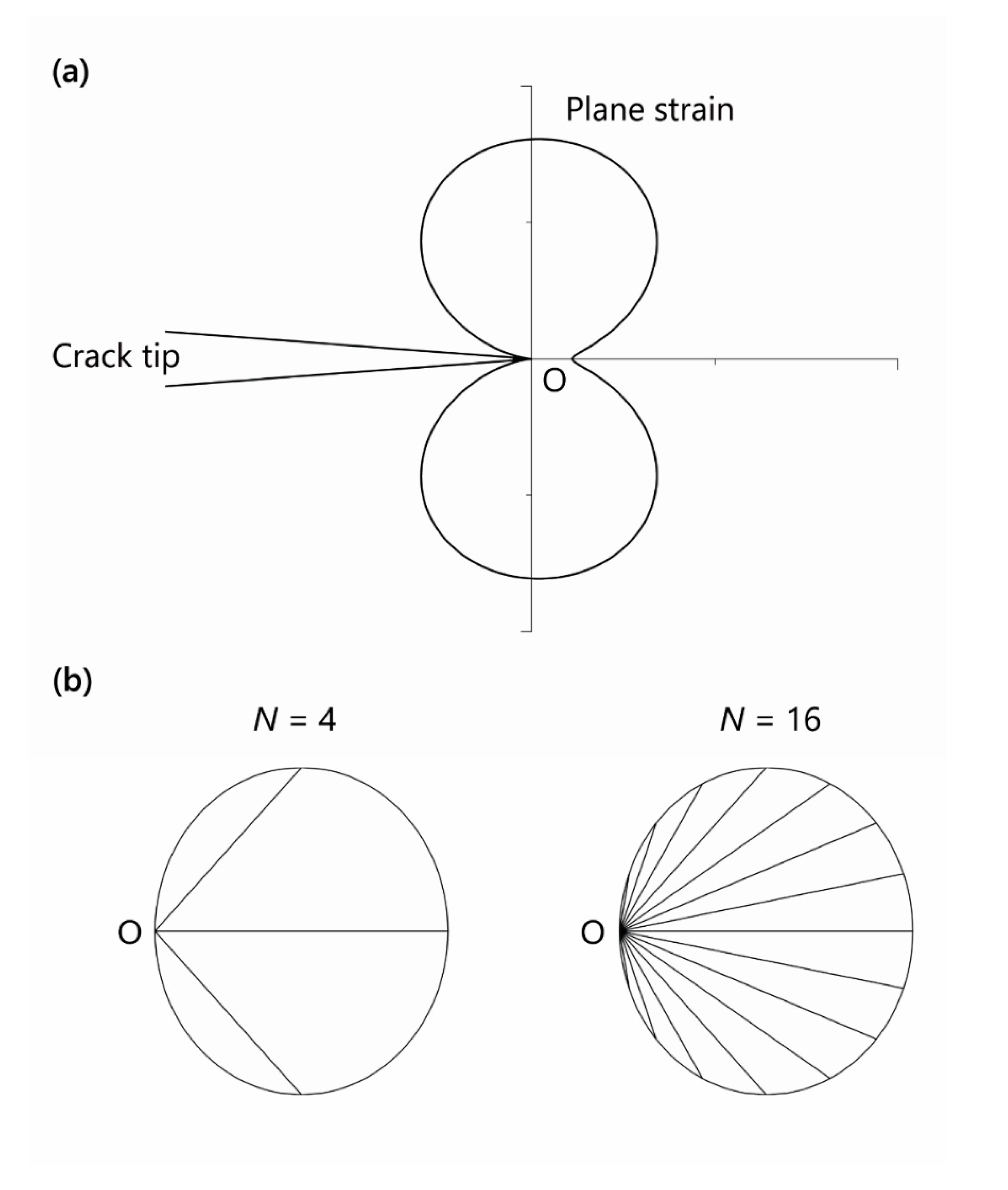
| C | Si | Mn | S | P | Cr | Mo | Fe | fRA | deff1 | κ2 | ||
|---|---|---|---|---|---|---|---|---|---|---|---|---|
| w.a. | w.l. | w.a. | w.l. | |||||||||
| 0.40 | 0.35 | 0.82 | 0.018 | 0.007 | 0.90 | 0.11 | Bal. | 0 | 2.5 | 0.9 | 0.4 | 0.4 |
| Symbol | Component | Type | Shear 1 |
|---|---|---|---|
| J1 | (0–11) [–211] | S/T | 0.11–0.58 |
| J2 | (1–10) [–1–12] | S/T | 0.11–0.58 |
| D1 | (11–2) [111] | S/T | 0.07–0.29 |
| D2 | (−1–12) [111] | S/T | 0.94 |
| E1 | (01–1) [111] | S/T | 0.09–0.81 |
| E2 | (0–11) [111] | S/T | 0.09–0.81 |
| F | (110) [001] | S/T | 0.05–0.09 |
| Cα | (110) [1–10] | T | 0.58 |
Publisher’s Note: MDPI stays neutral with regard to jurisdictional claims in published maps and institutional affiliations. |
© 2021 by the authors. Licensee MDPI, Basel, Switzerland. This article is an open access article distributed under the terms and conditions of the Creative Commons Attribution (CC BY) license (http://creativecommons.org/licenses/by/4.0/).
Share and Cite
Feng, J.; Barth, S.; Wettlaufer, M. Symmetry Breakdown Related Fracture in 42CrMo4 Steel. Metals 2021, 11, 344. https://doi.org/10.3390/met11020344
Feng J, Barth S, Wettlaufer M. Symmetry Breakdown Related Fracture in 42CrMo4 Steel. Metals. 2021; 11(2):344. https://doi.org/10.3390/met11020344
Chicago/Turabian StyleFeng, Jian, Stefan Barth, and Marc Wettlaufer. 2021. "Symmetry Breakdown Related Fracture in 42CrMo4 Steel" Metals 11, no. 2: 344. https://doi.org/10.3390/met11020344
APA StyleFeng, J., Barth, S., & Wettlaufer, M. (2021). Symmetry Breakdown Related Fracture in 42CrMo4 Steel. Metals, 11(2), 344. https://doi.org/10.3390/met11020344






